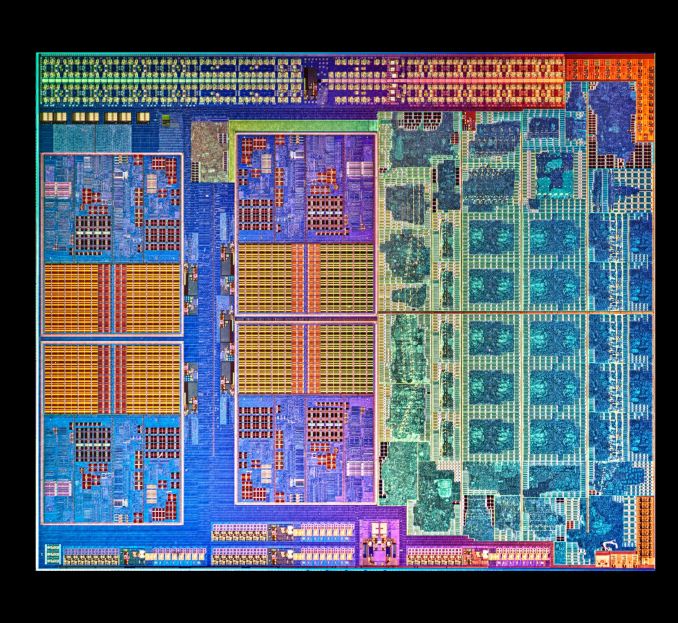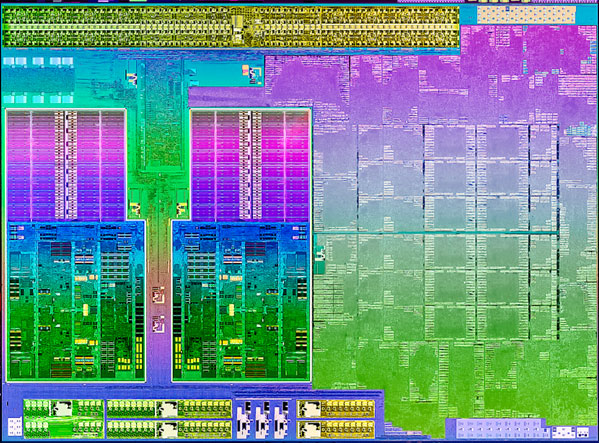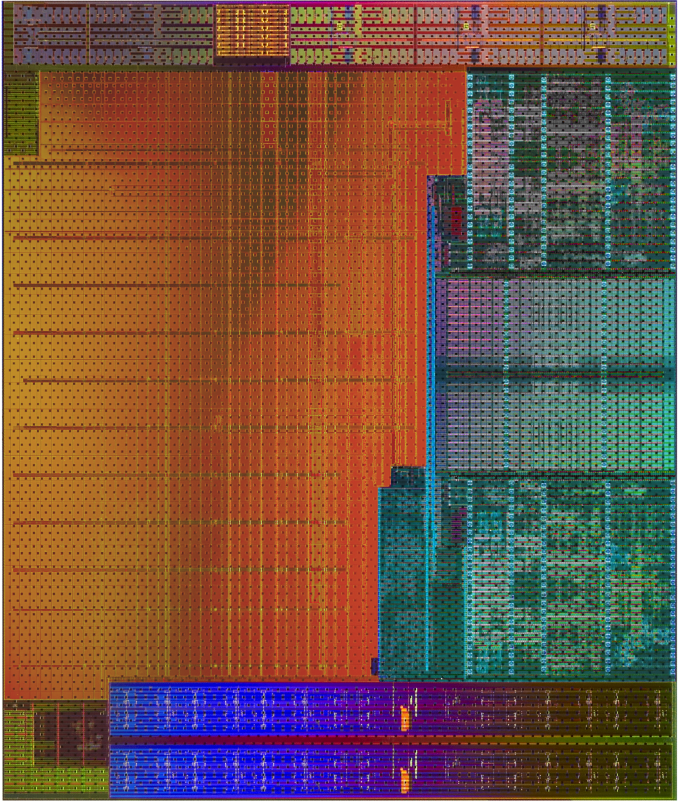AMD Kaveri Review: A8-7600 and A10-7850K Tested
by Ian Cutress & Rahul Garg on January 14, 2014 8:00 AM ESTLlano, Trinity and Kaveri Die: Compared
AMD sent along a high res shot of Kaveri's die. Armed with the same from the previous two generations, we can get a decent idea of the progression of AMD's APUs:
Llano, K10 Quad Core
Trinity and Richland Die, with two Piledriver modules and processor graphics
Kaveri, two modules and processor graphics
Moving from Llano to Trinity, we have the reduction from a fully-fledged quad core system to the dual module layout AMD is keeping with its APU range. Moving from Richland to Kaveri is actually a bigger step than one might imagine:
| AMD APU Details | ||||
| Core Name | Llano | Trinity | Richland | Kaveri |
| Microarch | K10 | Piledriver | Piledriver | Steamroller |
| CPU Example | A8-3850 | A10-5800K | A10-6800K | A10-7850K |
| Threads | 4 | 4 | 4 | 4 |
| Cores | 4 | 2 | 2 | 2 |
| GPU | HD 6550 | HD 7660D | HD 8670D | R7 |
| GPU Arch | VLIW5 | VLIW4 | VLIW4 | GCN 1.1 |
| GPU Cores | 400 | 384 | 384 | 512 |
| Die size / mm2 | 228 | 246 | 246 | 245 |
| Transistors | 1.178 B | 1.303 B | 1.303 B | 2.41 B |
| Power | 100W | 100W | 100W | 95W |
| CPU MHz | 2900 | 3800 | 4100 | 3700 |
| CPU Turbo | N/A | 4200 | 4400 | 4000 |
| L1 Cache |
256KB C$ 256KB D$ |
128KB C$ 64KB D$ |
128KB C$ 64KB D$ |
192KB C$ 64KB D$ |
| L2 Cache | 4 x 1MB | 2 x 2 MB | 2 x 2 MB | 2 x 2 MB |
| Node | 32nm SOI | 32nm SOI | 32nm SOI | 28nm SHP |
| Memory | DDR-1866 | DDR-1866 | DDR-2133 | DDR-2133 |
Looking back at Llano and Trinity/Richland, it's very clear that AMD's APUs on GF's 32nm SOI process had a real issue with transistor density. The table below attempts to put everything in perspective but keep in mind that, outside of Intel, no one does a good job of documenting how they are counting (estimating) transistors. My only hope is AMD's transistor counting methods are consistent across CPU and GPU, although that alone may be wishful thinking:
| Transistor Density Comparison | ||||||||
| Manufacturing Process | Transistor Count | Die Size | Transistors per mm2 | |||||
| AMD Kaveri | GF 28nm SHP | 2.41B | 245 mm2 | 9.837M | ||||
| AMD Richland | GF 32nm SOI | 1.30B | 246 mm2 | 5.285M | ||||
| AMD Llano | GF 32nm SOI | 1.178B | 228 mm2 | 5.166M | ||||
| AMD Bonaire (R7 260X) | TSMC 28nm | 2.08B | 160 mm2 | 13.000M | ||||
| AMD Pitcairn (R7 270/270X) | TSMC 28nm | 2.80B | 212 mm2 | 13.209M | ||||
| AMD Vishera (FX-8350) | GF 32nm SOI | 1.2B | 315 mm2 | 3.810M | ||||
| Intel Haswell 4C (GT2) | Intel 22nm | 1.40B | 177 mm2 | 7.910M | ||||
| NVIDIA GK106 (GTX 660) | TSMC 28nm | 2.54B | 214 mm2 | 11.869M | ||||
If AMD is indeed counting the same way across APUs/GPUs, the move to Kaveri doesn't look all that extreme but rather a good point in between previous APUs and other AMD GCN GPUs. Compared to standalone CPU architectures from AMD, it's clear that the APUs are far more dense thanks to big portions of their die being occupied by a GPU.













380 Comments
View All Comments
DryAir - Tuesday, January 14, 2014 - link
So at playble settings (30 fps+) kaveri is no better than richland. And both get outperformed by Iris Pro.jeffkibuule - Tuesday, January 14, 2014 - link
That CPU with Iris Pro costs $450 compared to these AMD chips which are far less expensive.takeship - Tuesday, January 14, 2014 - link
Only if you spring for the i7 variant. The i5 variant is ~300$. Still a premium over Kaveri, but you're also getting nearly double the CPU power.mr_tawan - Tuesday, January 14, 2014 - link
Also Iris comes only with R-variant of i5/i7. It won't run on your mainboard, so forget about DIY machine. You can always get a dGPU for that kind of machine though.just4U - Tuesday, January 14, 2014 - link
Is that why you can't buy the R variant at the usual places? I wasn't even aware that they are not compatible with regular 1150 boards.. hmmm.. that's to bad. I just thought they were in low supply or going to OEMs before they hit the retail channels.Gigaplex - Wednesday, January 15, 2014 - link
I'm pretty sure they only come in soldered-on variants.Klimax - Friday, January 17, 2014 - link
Correct, however some rumors say, that it won't be case with Broadwell/Haswell-refresh anymore. (Depends who is correct)thevoiceofreason - Tuesday, January 14, 2014 - link
Precisely. All those percentage improvement at 1080p graphs look very nice but are in the end moot if you realize you are looking at 12fps.At the end of the day, you can barely play at 720p.
methebest - Tuesday, January 14, 2014 - link
he needed to test them on low settings at 1080p.Principle - Tuesday, January 14, 2014 - link
Thats because they dont do these APUs any justice with their review strategy. They basically want to push GPUs, so they do not highlight the APU's actual capabilities. For example, how about some qualitative subjective analysis, rather than all of this easily comparative quantitative nonsense. I want to know at 1080p, what settings have to be turned down to be playable. Why in the world would they run these at Extreme settings??? Its absurd, unless you're trying to sell dGPUs. Where the AMD solutions really have an advantage is in the details. You likely can turn off AA and see the AMD FPS double, without nearly as big of jump by the Intel IGP where you would likely have to turn everything off or on low.